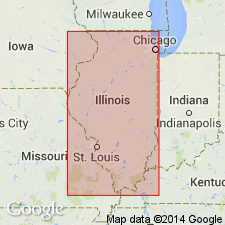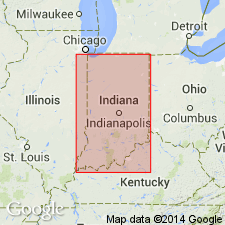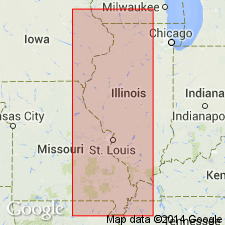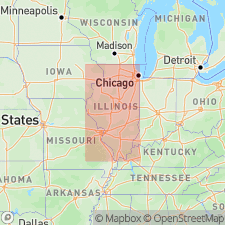
- Usage in publication:
-
- Ancell group
- Modifications:
-
- Original reference
- AAPG geologic province:
-
- Wisconsin arch
Summary:
Figs. 3, 11. Ancell group. Shown on columnar section as comprising (ascending) Kingdom, Daysville, Loughridge, and Harmony Hill formations. Underlies Platteville group; overlies Prairie du Chien group. Includes Glenwood subgroup [informal]. Age is Middle Ordovician.
[Notable exposures in Dixon-Oregon area, northern IL.]
["Subgroup" not recognized as a formal stratigraphic rank term (CSN, 1933; ACSN, 1961, 1970; NACSN, 1983, 2005, 2021). Considered informal and should not be capitalized.]
Source: US geologic names lexicon (USGS Bull. 1200, p. 93).

- Usage in publication:
-
- Ancell Group
- Modifications:
-
- Overview
- AAPG geologic province:
-
- Illinois basin
- Wisconsin arch
Summary:
Pg. 61-67. Ancell Group. In northern Illinois includes (descending) Glenwood and St. Peter Formations. In southern Illinois, includes (descending) Joachim, Dutchtown, and St. Peter Formations. Thickness up to 900 feet. Overlies Everton Dolomite; underlies Platteville Group. Age is Middle Ordovician (Chazyan).
Type section (composite): several sections in the bluffs between Dutchtown and Rock Levee, north of Ancell, Cape Girardeau Co., MO.
Source: Publication.

- Usage in publication:
-
- Ancell Group
- Modifications:
-
- Overview
- AAPG geologic province:
-
- Illinois basin
Summary:
(article by A.M. Burger and C.E. Weir). Ancell Group. Consists of St. Peter Sandstone overlain by and interlayered with (ascending) Dutchtown Formation and Joachim Dolomite. Thickness from about 50 feet in northern Indiana to 450+ feet in southern Indiana. Unconformably underlies Pecatonica Formation of Black River Group. Unconformably overlies Everton Dolomite of Knox Supergroup, or where Everton is absent, Prairie du Chien Group of Knox Supergroup. Age is Middle Ordovician (Champlainian; Chazyan to Blackriverian).
See also:
Droste, J.B., Abdulkareem, T.F., and Patton, J.B., 1982, Indiana Geol. Survey Occ. Paper, no. 36, 15 p.; and
Gutschick, R.C., IN Shaver, R.H., and Sunderman, J.A., eds., 1983 GSA, Indiana Geol. Survey, and Indiana Univ. Dept. Geol., Field trips in midwestern geology, p. 105-138.
Source: Publication.

- Usage in publication:
-
- Ancell Group
- Modifications:
-
- Revised
- AAPG geologic province:
-
- Illinois basin
Summary:
Definition of Ancell Group expanded to include the Everton Dolomite in the Illinois basin. As here defined, Ancell overlies the Sauk-Tippecanoe unconformity and underlies the sub-Platteville unconformity. Everton is included in Ancell because it does not appear to be genetically related to the Knox carbonates of the Sauk sequence. Ancell, in the Illinois basin, is therefore divided into (ascending) Everton Dolomite, St. Peter Sandstone, Dutchtown Limestone, and Joachim Dolomite. In the Wisconsin arch (northern Illinois and Wisconsin), Ancell consists of St. Peter Sandstone and Glenwood Formation.
Source: GNU records (USGS DDS-6; Reston GNULEX).

- Usage in publication:
-
- Ancell Group
- Modifications:
-
- Overview
- AAPG geologic province:
-
- Illinois basin
- Wisconsin arch
Kolata, D.R., 2005, Bedrock geology of Illinois: Illinois Geological Survey, no. 14.
Summary:
Ancell Group. In northern Illinois, includes Joachim Dolomite, up to 50 feet, and approximate equivalent Glenwood Formation, up to 75 feet, at top, interlayered with and underlain by up to 600 feet of St. Peter Sandstone. In southern Illinois, subdivided into (descending): Joachim Dolomite, 0 to 450 feet; Dutchtown Limestone, 0 to 300 feet; and St. Peter Sandstone, 75 to 350 feet. Unconformably overlies Shakopee Dolomite of Prairie du Chien Group in northern Illinois, and Everton Formation of Knox Group in southern Illinois. Underlies Pecatonica Formation of Platteville Group. Age is Middle to Late Ordovician (Whiterockian to Mohawkian).
Source: Publication.
For more information, please contact Nancy Stamm, Geologic Names Committee Secretary.
Asterisk (*) indicates published by U.S. Geological Survey authors.
"No current usage" (†) implies that a name has been abandoned or has fallen into disuse. Former usage and, if known, replacement name given in parentheses ( ).
Slash (/) indicates name conflicts with nomenclatural guidelines (CSN, 1933; ACSN, 1961, 1970; NACSN, 1983, 2005, 2021). May be explained within brackets ([ ]).

